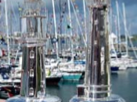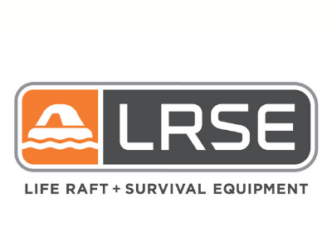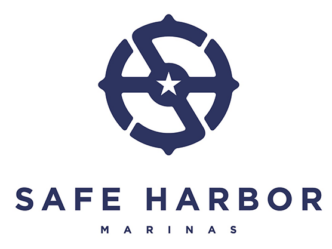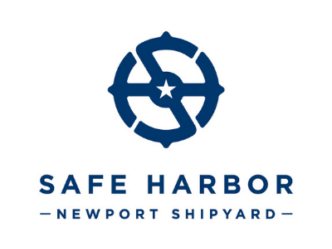How to Win the Bermuda Race – Words from Past Winners
Everybody knows there are plenty of ways to lose a Bermuda Race, but only a very few people actually know how to win one. Listen to what the winners have to say, culled from the race’s official history, A Berth to Bermuda, by John Rousmaniere.

(Click on links to open)
[toggle title_open="Be an Admiral - Carleton Mitchell, three-time winner in Finisterre (1956, 1958, 1960)" title_closed="Be an Admiral - Carleton Mitchell, three-time winner in Finisterre (1956, 1958, 1960)" hide="yes" border="yes" style="default" excerpt_length="0" read_more_text="Read More" read_less_text="Read Less" include_excerpt_html="no"]
One of Finisterre’s regular crew, Bunny Rigg, put her success down to owner-skipper Carleton Mitchell’s “good admiralship” – meaning his powers of organization and leadership. Mitchell said this: “My theory was that the time to get everything right is before you leave the dock. And then, once you leave the dock, to be able to drive the hell out of the boat and never have to worry about something carrying away. And if anything did let go on you, the spares were on board with the know-how to put it back together.”
This confidence allowed Finisterre’s crew to drive hard all the time. “We have a basic tenet to keep moving at maximum speed in the wind of the moment. There must be either a trim or a shift in sails every time there is a variation.”
Mitchell was a perfectionist about navigation, but though he himself was a skilled celestial navigator, he signed on one other navigator of equal ability so a sight would be taken instantaneously when the overcast momentarily cleared.
Mitch (as everybody called him) firmly believed in the value of a well-fed, well-rested crew. After eating a fine meal prepared by the full-time cook, they climbed into their bunks with eye shades and ear plugs provided by the skipper. This approach paid off nicely in the tough final 100 miles of the demanding 1958 race, said Bunny Rigg: “These conditions called for a lot of rugged exertion in the last 12 hours of the race and many a crew was too fatigued at this stage of the game to do their best. Finisterre passed many of her competitors right there, rolling reefs in and out and changing headsails no less than 20 times with the fluctuations of the breeze simply because she had a well-rested crew.” [/toggle]
[toggle title_open="Prepare, Prepare, Prepare - Larry Huntington, 1990 winner, Denali" title_closed="Prepare, Prepare, Prepare -- Larry Huntington, 1990 winner, Denali" hide="yes" border="yes" style="default" excerpt_length="0" read_more_text="Read More" read_less_text="Read Less" include_excerpt_html="no"]
Huntington is a demon on preparation. “I don’t sleep well before the race until I stop thinking about anything that’s left undone. Everything you can think about is fair game. If the preparation is as good as you can get it, then your mind’s free to think about how you can sail the boat and where you can take the boat. When shortening sail is no longer a safety question, it becomes a boat speed question.”
This confidence allowed Huntington to take chances. In 1990 he sailed his cat-ketch Denali west of the rhumb line in search of the southwest wind he believed would fill in. “We sailed for a while on the port tack but there was no southwesterly, so I said we should tack back to starboard. That’s when my son Chris said, ‘What are we doing? We’re chickening out!’ So we kept going until we were more than 120 miles west of the rhumb line.” The southwesterly found Denali, she tacked, and she sprinted to the finish while almost everybody else, to the east, pounded upwind. Denali won the race by two hours.
[/toggle]
[toggle title_open="Start with Lady Luck - Peter Bowker, navigator, 1974 winner Merrythought" title_closed="Start with Lady Luck - Peter Bowker, navigator, 1974 winner Merrythought" hide="yes" border="yes" style="default" excerpt_length="0" read_more_text="Read More" read_less_text="Read Less" include_excerpt_html="no"]
Start with Lady Luck - Peter Bowker, navigator, 1974 winner Merrythought)
1. Ensure that Lady Luck is one of your crew. Use witchcraft. Rubbing chicken bones together with suitable incantations might work.
2. Pick a good boat and ensure you sail with a good crew who know the boat.
3. Ensure the skipper, the watch captains, and navigator have studied the Gulf Stream satellite photos and have a plan of action before you leave Newport. Negotiating the Stream is of course the crucial part of this race. Get it right and you can be on the prize list. Get it wrong and you’re toast!
4. If conditions change during the course of the race, especially when approaching the Stream, don't be afraid to wake people up for a tactical discussion. As a navigator I have had serious qualms when left to my own devices when it came to making strategic and tactical decisions.
[/toggle]
[toggle title_open="Know the Gulf Stream - Stan Honey, navigator, Pyewacket, 2002" title_closed="Know the Gulf Stream Stan Honey, navigator, Pyewacket, 2002" hide="yes" border="yes" style="default" excerpt_length="0" read_more_text="Read More" read_less_text="Read Less" include_excerpt_html="no"]
“My impression of the Bermuda Race is that an analytical approach to course selection can work pretty well. I think this is because the Stream is such a large influence on tactics in that race, and the forecasts of the Stream tend to be far more dependable than weather forecasts. This is because the Stream’s location and direction change slowly and relatively predictably. So for the Bermuda Race, the optimum route that you can
compute from accurate polars, forecasts of the Stream, and weather forecasts often turns out to be a pretty good choice.”
[/toggle]
[toggle title_open="Use the Gulf Stream - Richard du Moulin, winner Double-Handed Division, Lora Ann" title_closed="Use the Gulf Stream - Richard du Moulin, winner Double-Handed Division, Lora Ann" hide="yes" border="yes" style="default" excerpt_length="0" read_more_text="Read More" read_less_text="Read Less" include_excerpt_html="no"]
“Especially in a smaller boat, you’ve got to go into it in a way that will optimize the current. You have to throw away the ‘sail the favored tack’ way of thinking. You’ve got to be willing to make radical deviations of course so you can sail from doughnut to doughnut, from cold eddy to cold eddy. If another boat seems to be doing better than she should, she must be in better current. In 2002 we looked around and found ourselves in weak current, and so we very painfully squared the spinnaker pole and ran off for an hour. If we hadn’t, we would have missed 15 hours of 4-knot favorable current.”
[/toggle]
[toggle title_open="Be Prepared to Take Chances - Richard Nye, winner 1952, 1970, Carina" title_closed="Be Prepared to Take Chances - Richard Nye, winner 1952, 1970, Carina" hide="yes" border="yes" style="default" excerpt_length="0" read_more_text="Read More" read_less_text="Read Less" include_excerpt_html="no"]
Some people preach playing it safe, sailing near the rhumb line, but many races are won by risk-takers. “We used to swing for the fences quite a bit” says Richard Nye, who with his father, Dick Nye, sailed three boats called Carina to one of the best ocean-racing records ever.
Yes, indeed. In the 1982 Bermuda Race, Carina was hard on the wind on starboard tack, almost laying Bermuda. The on-watch was settling down for a long leg to the finish when Richard Nye poked his head up through the companionway and took a look around. Way up to windward, a lightning bolt flashed down to the water.
“Tack,” Nye ordered. The crew looked at him incredulously. Someone told him they were only 10 degrees off the layline to the finish
“Tack. There’s lightning to windward. The Stream’s up there.”
Carina tacked and sailed away from Bermuda for a couple of hours until she was well into hot water and a 3-knot current bound southeast. Nye then tacked back. Carina won the IOR division by a comfortable 34 minutes and came within minutes of winning her third St. David’s Lighthouse Trophy.
In the 1972 race to Spain, Carina was drifting along when Nye heard a radio report indicating more wind to the north. He abruptly turned 90 degrees to port. “When the other watch came on deck, they were so mad they wouldn’t talk to me.” Carina sailed north for almost 24 hours, found better wind, turned east, and won the race.
[/toggle]
[toggle title_open="Have a Sense of Humor - Alfred F. Loomis" title_closed="Have a Sense of Humor - Alfred F. Loomis" hide="yes" border="yes" style="default" excerpt_length="0" read_more_text="Read More" read_less_text="Read Less" include_excerpt_html="no"]
This mock pre-race interview of a Bermuda Race skipper by race veteran and boating writer Alfred F. Loomis reveals some of the imponderables of beating down to the Onion Patch.
Question: Do you feel yourself qualified to give any advice about how the race should be sailed?
Answer: Yes and no.
Q: Answer the last part first.
A: I’ve sailed it wrong so many times I ought to know how to sail it right.
Q: What weather do you expect this year?
A: Average weather, anything from a calm to half a gale.
Q: Ahead, or abaft the beam?
A: Oh, definitely.
Q: Now, with a falling barometer and the wind in the east southeast would you get well to westward of the base line so that you would be sitting pretty when a southwester came in?
A: I didn’t last time, but I certainly would this.
Q: With what anticipated result?
A: That the wind would stay where it was and throw me for a loss.
Q: Do you have any opinion concerning the Gulf Stream?
A: I disapprove of it.
[/toggle]
[toggle title_open="How to Win a Bermuda Race – Love Sailing, Push Hard -Carleton Mitchell, three-time winner in Finisterre (1956, 1958, 1960)" title_closed="How to Win a Bermuda Race – Love Sailing, Push Hard -Carleton Mitchell, three-time winner in Finisterre (1956, 1958, 1960)" hide="yes" border="yes" style="default" excerpt_length="0" read_more_text="Read More" read_less_text="Read Less" include_excerpt_html="no"]
Carleton Mitchell loved the challenge of going to sea with an able crew. He wrote this in the middle of one ocean race:
“Here we are, nine men, driving a fragile complex of wood, metal, and cloth through driving rain and building sea, a thousand miles from the nearest harbor; no one to see or admire or applaud; no one to help if our temerity ends in disaster. . . .
“Our attitude is not even wholly based on the competitive aspect of racing. It is that we all feel there is just one way to do things, one standard, one code, and we live up to it for our own satisfaction. We are driven by our own compulsions, each personal and secret, so nebulous we probably could not express them to our mates if we tried.
“But in our own way, we are about as dedicated as it is possible for men to be.”
[/toggle]
Latest Bermuda Race News
July 9, 2024

The Loss of Solution on Return Delivery
On July 2nd, during the return delivery from the 2024 Newport Bermuda Race, the crew of Solution abandoned their 50-foot sloop, 200 miles south of Cape Cod, and were safely […]
June 29, 2024
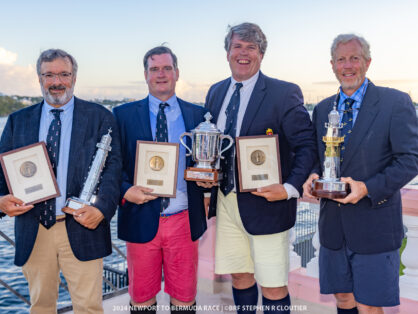
Race Wrap Up – Historic 53rd Newport Bermuda Race Concludes with Prize-Giving
Final winners and awards announced on Saturday Photo: Steve Cloutier [Hamilton, Bermuda] - The 53rd Newport Bermuda Race officially came to a close this evening, as winners and award recipients […]
June 27, 2024
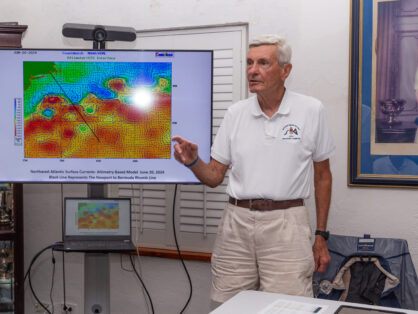
Navigators’ Forum Recap: Expert Insights and Winning Strategies
The 2024 Navigator's Forum

